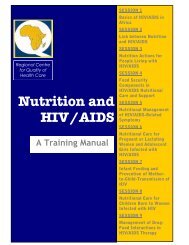2.1: Anthropometric Indicators Measurement Guide - Linkages Project
2.1: Anthropometric Indicators Measurement Guide - Linkages Project
2.1: Anthropometric Indicators Measurement Guide - Linkages Project
Create successful ePaper yourself
Turn your PDF publications into a flip-book with our unique Google optimized e-Paper software.
P ART<br />
1.Introduction<br />
1.<br />
This guide provides information on the <strong>Anthropometric</strong> Impact<br />
<strong>Indicators</strong> and the Annual Monitoring <strong>Indicators</strong> for Maternal and<br />
Child Health/Child Survival (MCH/CS) and income-related Title II<br />
activities, a subset of the P.L. 480 Title II Generic Performance <strong>Indicators</strong> for<br />
Development Activities. The impact indicators are:<br />
• decreased percent of stunted children (presented for ages 24-60<br />
months and by gender), where stunting is defined as percent of children<br />
falling below -2 standard deviations for height-for-age;<br />
• decreased percent of underweight children (in specified age<br />
groupings such as 12-24 months 36-59 months and by gender) where<br />
underweight is defined as percent of children falling below -2 standard<br />
deviations for weight-for-age.<br />
These indicators are required for the reports of projects with specific<br />
nutrition components and are collected at baseline, mid-term and final-year<br />
evaluations. Stunting, reflected by deficits in height-for-age would not be<br />
expected to change in a short time period. It is recommended, therefore, not<br />
to report stunting figures annually. Underweight (or weight for age), reported<br />
for specific age groupings, would change more quickly as it is influenced by<br />
short-term effects such as a recent outbreak of diarrheal diseases.<br />
Some programs report stunting for children under 24 months of age<br />
rather than the recommended 24-60 months age grouping. Restricting the<br />
age grouping to children under 24 months has the disadvantage of not<br />
capturing the lagged effects of the program and reducing the numbers of<br />
potential participants in a survey. The advantage of using children under 24<br />
months is that the data are more useful to determine the factors related to<br />
stunting for program design or redesign.<br />
The monitoring indicators are:<br />
• increased percent of eligible children in growth<br />
monitoring/promotion (usually presented for children

















